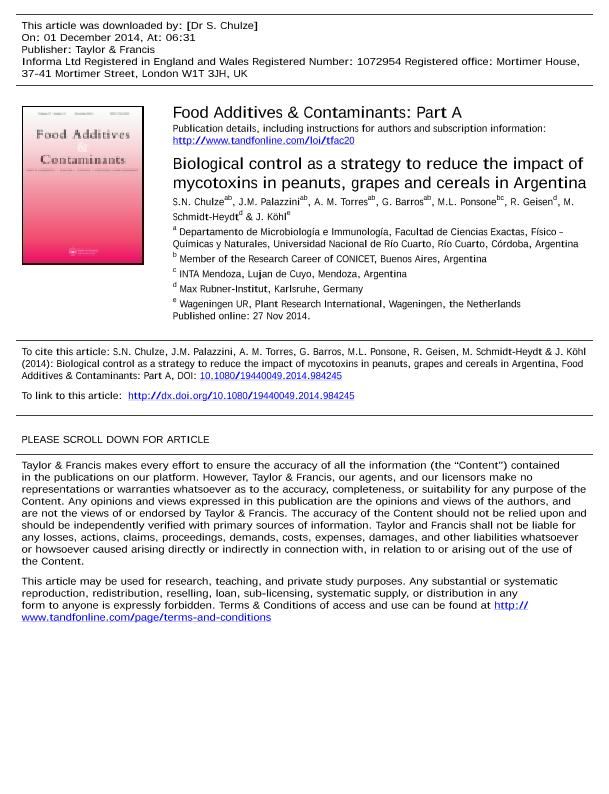Mostrar el registro sencillo del ítem
dc.contributor.author
Chulze, Sofia Noemi

dc.contributor.author
Palazzini, Juan Manuel

dc.contributor.author
Torres, Adriana Mabel

dc.contributor.author
Barros, Germán Gustavo

dc.contributor.author
Ponsone, Maria Lorena

dc.contributor.author
Geisen, R.
dc.contributor.author
Schmidt Heydt, M.
dc.contributor.author
Köhl, J.
dc.date.available
2018-01-03T21:59:02Z
dc.date.issued
2014-11
dc.identifier.citation
Köhl, J.; Schmidt Heydt, M.; Geisen, R.; Ponsone, Maria Lorena; Barros, Germán Gustavo; Torres, Adriana Mabel; et al.; Biological control as a strategy to reduce the impact of mycotoxins in peanuts, grapes and cereals in Argentina; Taylor & Francis; Food Additives and Contaminants: Part A; 32; 4; 11-2014; 471-479
dc.identifier.issn
1944-0049
dc.identifier.uri
http://hdl.handle.net/11336/32253
dc.description.abstract
Mycotoxins including aflatoxins, deoxynivalenol, fumonisins and ochratoxin A are among the main fungal secondary metabolites detected as natural contaminants in South America in different commodities such as peanuts (aflatoxins), cereals (deoxynivalenol and fumonisins) or grapes (ochratoxin A). Different strategies including crop rotation, tillage practices, fungicide application and planting less susceptible cultivars are used in order to reduce the impact of these mycotoxins in both food and feed chains. The development of fungicide resistance in many fungal pathogens as well as rising of public concern on the risks associated with pesticide use led to the search for alternative environmentally friendly methods. Biological control of plant pathogens and toxigenic fungi offers an alternative that can complement chemical control in the frame of an integrated pest management to reduce the impact of mycotoxins in the food and feed chains. The advances made in Argentina on reducing the impact of toxigenic fungi and mycotoxins in peanut, grapes and cereals using the biocontrol strategy are summarised. Native bacteria, yeasts and filamentous fungi have been selected to evaluate them as potential biocontrol agents. Field trials showed that Bacillus subtilis RC 218 and Brevibacillus sp. RC 263 were effective at reducing deoxynivalenol accumulation in wheat. The application of Clonostachys rosea isolates on wheat stubble reduced Fusarium colonisation on the stubble. Bacillus amyloliquefaciens and Microbacterium oleovorans showed good activity to control both Fusarium verticillioides growth and the accumulation of fumonisins at pre-harvest stage in maize. Control of toxigenic Aspergillus flavus and aflatoxin accumulation in peanuts was achieved using a native atoxigenic Aspergillus flavus strain based on competitive exclusion of the toxigenic strains. Kluyveromyces thermotolerans strains were used as biocontrol agents to reduce the impact of Aspergillus section Nigri and ochratoxin A accumulation in grapes.
dc.format
application/pdf
dc.language.iso
eng
dc.publisher
Taylor & Francis

dc.rights
info:eu-repo/semantics/openAccess
dc.rights.uri
https://creativecommons.org/licenses/by-nc-sa/2.5/ar/
dc.subject
Biocontrol
dc.subject
Aspergillus
dc.subject
Fusarium
dc.subject
Mycotoxin
dc.subject.classification
Otras Ciencias Biológicas

dc.subject.classification
Ciencias Biológicas

dc.subject.classification
CIENCIAS NATURALES Y EXACTAS

dc.title
Biological control as a strategy to reduce the impact of mycotoxins in peanuts, grapes and cereals in Argentina
dc.type
info:eu-repo/semantics/article
dc.type
info:ar-repo/semantics/artículo
dc.type
info:eu-repo/semantics/publishedVersion
dc.date.updated
2018-01-03T20:00:41Z
dc.journal.volume
32
dc.journal.number
4
dc.journal.pagination
471-479
dc.journal.pais
Reino Unido

dc.journal.ciudad
Londres
dc.description.fil
Fil: Chulze, Sofia Noemi. Universidad Nacional de Río Cuarto. Facultad de Ciencias Exactas, Fisicoquímicas y Naturales. Departamento de Microbiología e Inmunología. Cátedra de Micología; Argentina. Consejo Nacional de Investigaciones Científicas y Técnicas. Centro Científico Tecnológico Conicet - Mendoza; Argentina
dc.description.fil
Fil: Palazzini, Juan Manuel. Consejo Nacional de Investigaciones Científicas y Técnicas. Centro Científico Tecnológico Conicet - Mendoza; Argentina. Universidad Nacional de Río Cuarto. Facultad de Ciencias Exactas, Fisicoquímicas y Naturales. Departamento de Microbiología e Inmunología. Cátedra de Micología; Argentina
dc.description.fil
Fil: Torres, Adriana Mabel. Consejo Nacional de Investigaciones Científicas y Técnicas. Centro Científico Tecnológico Conicet - Mendoza; Argentina. Universidad Nacional de Río Cuarto. Facultad de Ciencias Exactas, Fisicoquímicas y Naturales. Departamento de Microbiología e Inmunología. Cátedra de Micología; Argentina
dc.description.fil
Fil: Barros, Germán Gustavo. Consejo Nacional de Investigaciones Científicas y Técnicas. Centro Científico Tecnológico Conicet - Mendoza; Argentina. Universidad Nacional de Río Cuarto. Facultad de Ciencias Exactas, Fisicoquímicas y Naturales. Departamento de Microbiología e Inmunología. Cátedra de Micología; Argentina
dc.description.fil
Fil: Ponsone, Maria Lorena. Consejo Nacional de Investigaciones Científicas y Técnicas. Centro Científico Tecnológico Conicet - Mendoza; Argentina. Instituto Nacional de Tecnología Agropecuaria; Argentina
dc.description.fil
Fil: Geisen, R.. Max Rubner-Institut; Alemania
dc.description.fil
Fil: Schmidt Heydt, M.. Max Rubner-Institut; Alemania
dc.description.fil
Fil: Köhl, J.. Wageningen UR. Plant Research International, Wageningen; Países Bajos
dc.journal.title
Food Additives and Contaminants: Part A
dc.relation.alternativeid
info:eu-repo/semantics/altIdentifier/doi/http://dx.doi.org/10.1080/19440049.2014.984245
dc.relation.alternativeid
info:eu-repo/semantics/altIdentifier/url/http://www.tandfonline.com/doi/abs/10.1080/19440049.2014.984245
Archivos asociados
